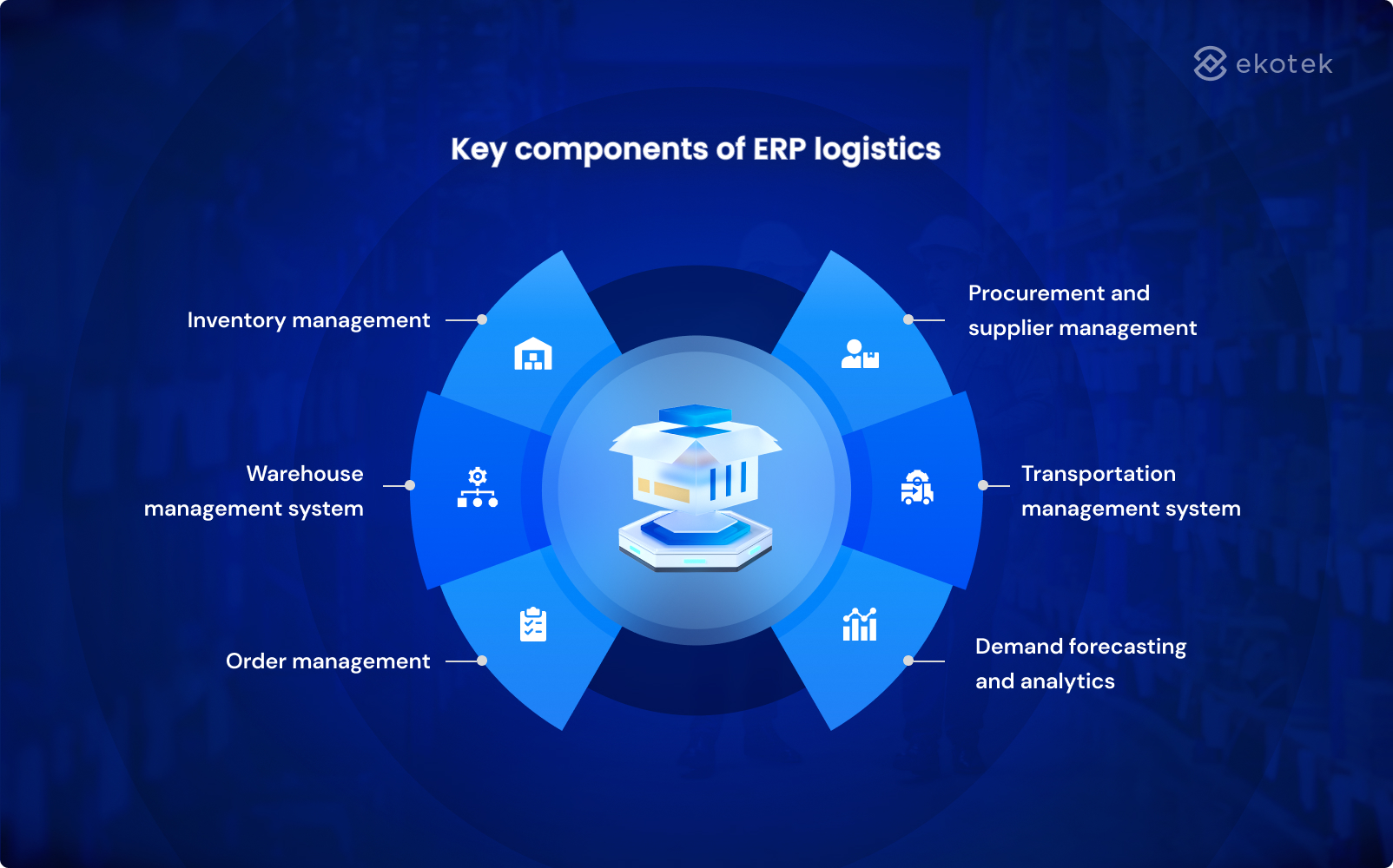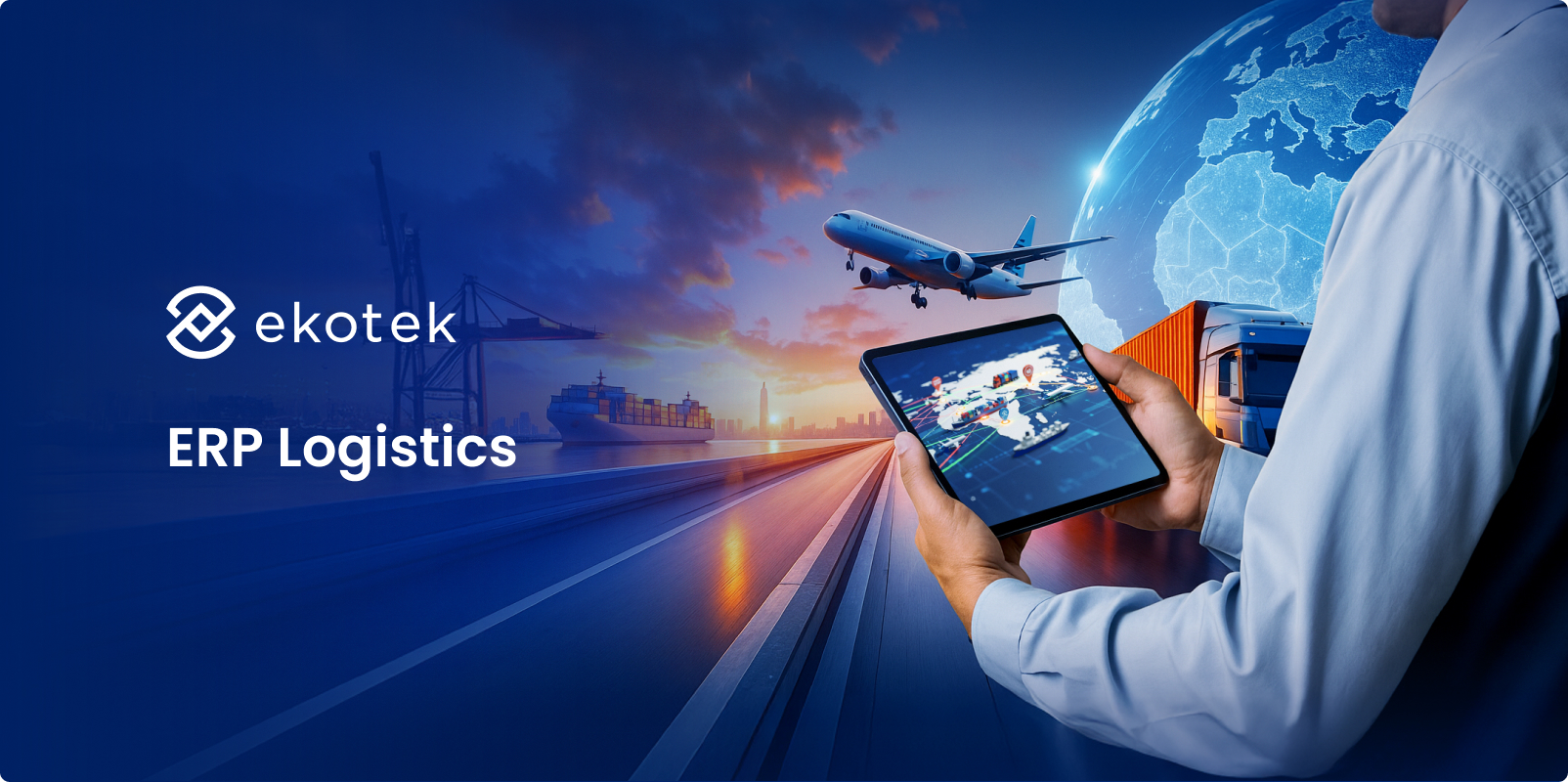
- 1
- 2
- 3
- 4
- 5
- 6
- 7
- 8
- 9
Introduction
In today’s fast-paced business environment, managing logistics effectively is a critical priority for organizations across all industries. Whether you’re in retail, distribution, manufacturing, or e-commerce, rising customer expectations, global disruptions, and complex supply networks are putting unprecedented pressure on logistics operations. According to a 2024 McKinsey report, over 70% of business leaders are planning to invest in digital solutions to improve supply chain visibility, efficiency, and resilience. Yet, many companies still rely on siloed systems, spreadsheets, or outdated software, resulting in inefficiencies, delays, and limited oversight.
ERP logistics presents a game-changing solution. By centralizing logistics and supply chain operations within an ERP (Enterprise Resource Planning) system, businesses can unlock efficiency, agility, and data-driven decision-making.
In this blog, we’ll explore what ERP logistics is, its core components, the benefits it delivers, and how to choose the right solution to gain a competitive edge.
What is ERP logistics?
ERP logistics is a centralized system that combines all logistics and manufacturing activities, like inventory, warehousing, procurement, transportation, and demand planning into one platform.
Instead of using multiple separate tools for each task, ERP logistics allows businesses to manage everything from a single dashboard. This leads to better coordination, real-time data visibility, and smarter decisions.
| Aspect | ERP logistics | Standalone logistics software |
|---|---|---|
| Scope | Covers full logistics and supply chain | Focuses on a specific function (WMS, TMS) |
| Data integration | Unified data across all departments | Data silos between systems |
| Decision-making | Real-time insights from end-to-end processes | Limited view based on one function |
| Scalability | Designed for growing/multi-location businesses | May require multiple tools to scale |
| Maintenance and upgrades | Centralized updates and vendor support | Separate maintenance for each tool |
| User experience | One login, consistent UI across functions | Different interfaces, more training needed |
While standalone logistics tools can solve individual problems, ERP logistics offers a holistic approach. For businesses aiming to grow, improve coordination, and make faster decisions, ERP logistics provides the scalability and visibility that fragmented systems cannot match.
💡 Want to go beyond ERP logistics? Discover the full roadmap to smarter operations in our 2025 Digital transformation in manufacturing guide.
Key components of ERP logistics
Inventory management
The inventory management module allows businesses to track stock levels, SKUs, batch numbers, and stock movements across all warehouses in real time. It helps ensure the right products are available at the right locations, reducing both stockouts and overstocking.
Key capabilities include:
- Automatic calculation of reorder points
- Visibility across multiple storage locations
- Stock aging and valuation analysis
Warehouse management system (WMS)
The WMS module manages the physical handling of goods inside warehouses. It supports efficient layout planning and automates key warehouse operations.
It typically includes:
- Bin and zone management to optimize storage space
- Integration with barcode or RFID scanning for real-time accuracy
- Automation of picking, packing, and shipping workflows
Order management
Order management covers the complete lifecycle of customer and supplier orders. It ensures that sales and purchase orders are processed accurately and on time.
This module supports:
- Real-time order tracking from placement to delivery
- Automated invoicing and credit note generation
- Handling of order changes, cancellations, and returns
Procurement and supplier management
This component simplifies the sourcing and purchasing process while strengthening supplier relationships. It helps businesses make better purchasing decisions and maintain supply continuity.
Key functions include:
- Supplier performance tracking and rating
- Purchase requisition, approval, and PO generation
- Contract and compliance management
Transportation management system (TMS)
The TMS module plans and manages the movement of goods across locations. It supports both inbound and outbound logistics and helps optimize delivery performance.
Typical features include:
- Route and carrier selection based on cost and lead time
- Freight cost calculation and invoice matching
- Real-time shipment tracking and exception alerts
Demand forecasting and analytics
This module uses historical data and predictive models to forecast future demand.
It helps align inventory, purchasing, and production with actual market needs.
Key capabilities:
- Forecasting based on sales trends and seasonality
- Integration of promotional calendars and market events
- Scenario planning to test different business assumptions
💡 Unlock smarter, faster production with our Ultimate guide to manufacturing process automation.
Benefits of ERP logistics for businesses
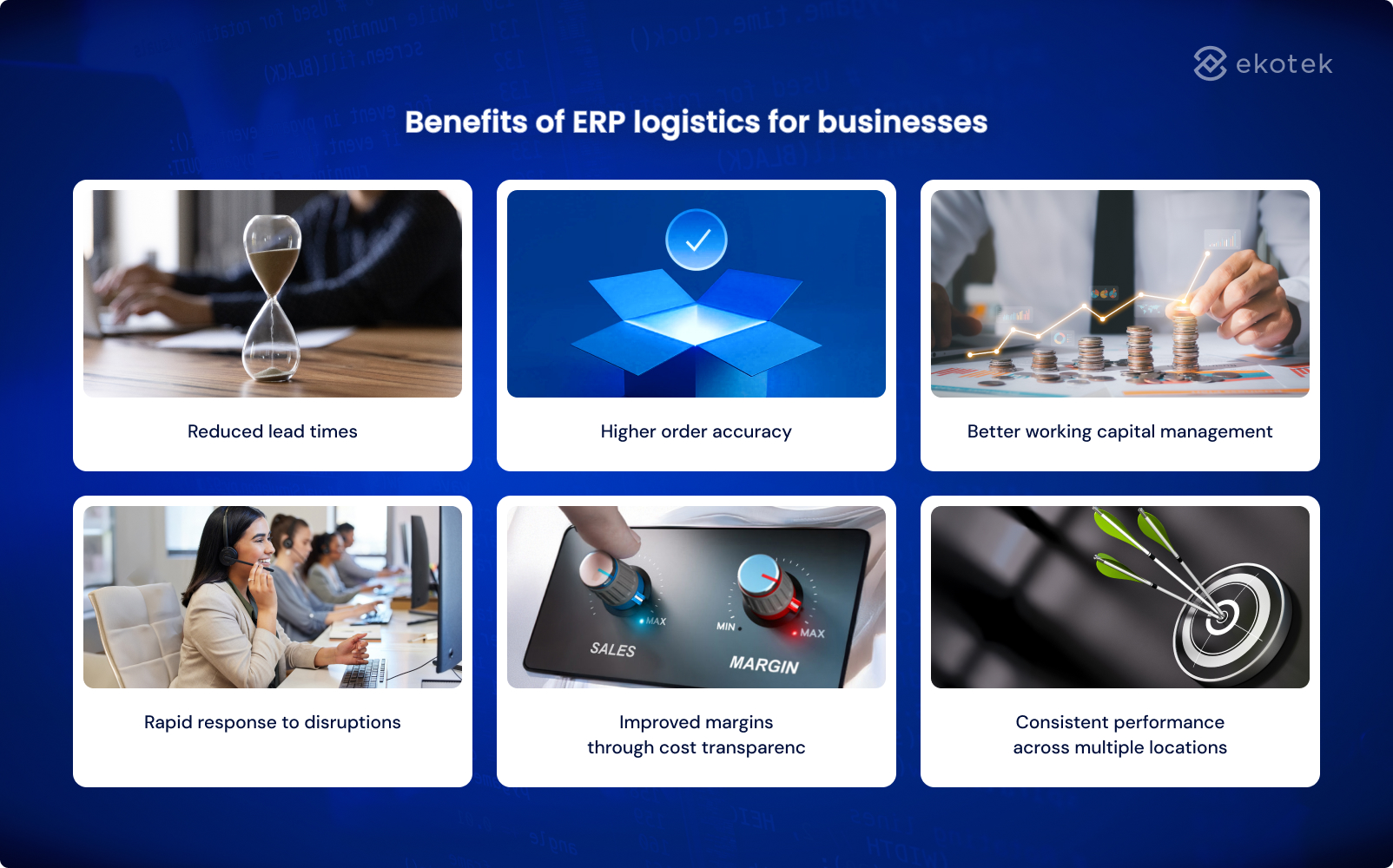 Reduced lead times
Reduced lead times
ERP logistics integrates procurement, inventory, and transportation planning into a single, synchronized flow. This integration reduces lag between order, fulfillment, and delivery processes.
As a result, businesses can shorten order-to-delivery cycles and respond to customer demand more quickly, without increasing inventory levels.
Higher order accuracy and fewer returns
When all departments work within a single system, data consistency is guaranteed. Sales orders automatically reflect in inventory and warehouse operations, eliminating common manual errors.
This leads to a noticeable drop in mis-shipments and return rates, improving customer satisfaction while reducing reverse logistics costs.
Better working capital management
Real-time inventory visibility and automated replenishment rules allow for tighter control over stock levels. Purchases are made based on actual demand forecasts and sales velocity, not guesswork.
Consequently, businesses can free up cash that would otherwise be tied up in excess stock, while still maintaining service levels.
Rapid response to disruptions
ERP logistics provides end-to-end visibility into supply chain activities, enabling early detection of disruptions, such as supplier delays or transport issues.
This allows managers to act quickly, rerouting shipments or adjusting orders before problems escalate, helping maintain service continuity with minimal financial impact.
Improved margins through cost transparency
With logistics and procurement data centralized, businesses can calculate the full landed cost of goods, including shipping, storage, and supplier-specific terms.
This detailed cost insight supports smarter sourcing decisions and pricing strategies, ultimately leading to higher product margins.
Consistent performance across multiple locations
ERP logistics standardizes logistics processes across sites while allowing for local customization where needed. It ensures that all locations operate under a unified data structure and workflow.
This consistency enables businesses to scale more effectively, maintain quality across markets, and reduce the overhead of managing disconnected systems.
Use cases and industries that benefit most
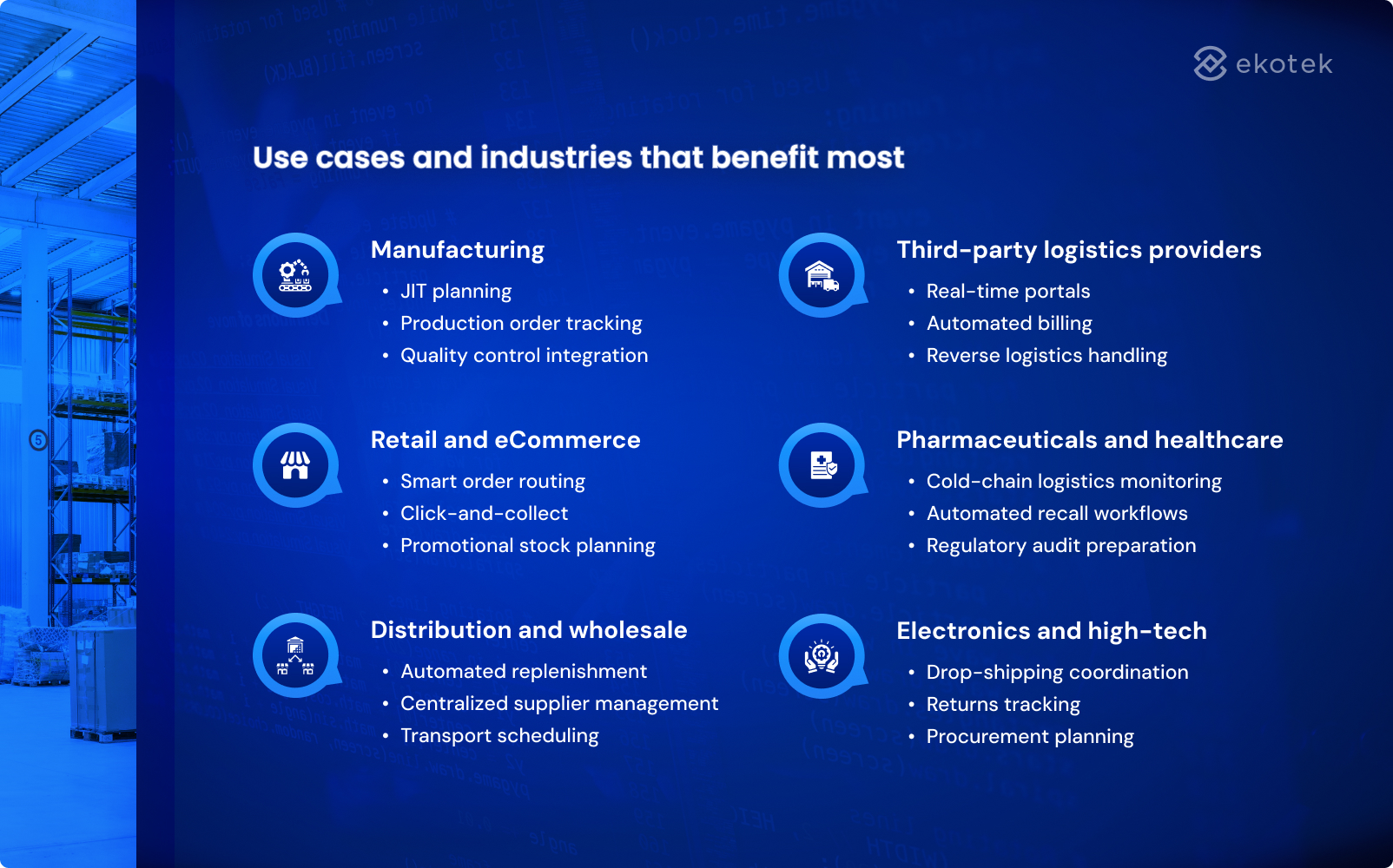 Manufacturing
Manufacturing
Manufacturers deal with complex planning, supplier coordination, and production timing. ERP logistics helps streamline every stage, from raw material procurement to final delivery.
Common use cases:
- Just-in-time (JIT) planning: Align raw material arrival with production schedules to reduce inventory holding costs.
- Multi-plant inventory visibility: Monitor and rebalance raw materials and finished goods across multiple factories.
- Production order tracking: Link work orders with procurement, BOMs, and delivery timelines for real-time progress monitoring.
- Quality control integration: Automate quality check workflows and hold/release procedures in the warehouse.
Retail and eCommerce
Retailers and eCommerce brands require fast, accurate order fulfillment and unified inventory across multiple channels.
Common use cases:
- Omnichannel inventory sync: Real-time stock visibility across stores, marketplaces, and warehouses.
- Smart order routing: Automatically direct orders to the closest warehouse/store with available stock.
- Click-and-collect (BOPIS): Coordinate in-store pickups with online orders and store inventory.
- Promotional stock planning: Use past campaign data to forecast and allocate stock ahead of sales events.
💡 Discover why digital transformation matters for retail in 2025 in our latest guide.
Distribution and wholesale
Distributors need to handle bulk purchasing, regional deliveries, and frequent stock movement across multiple warehouses.
Common use cases:
- Automated replenishment: Set rules for reorder points based on SKU velocity and seasonality.
- Centralized supplier management: Track performance, pricing, and fulfillment rates across suppliers.
- Inventory aging and turnover analysis: Flag slow-moving stock and optimize purchasing patterns.
- Transport and delivery scheduling: Plan efficient routes for regional deliveries based on delivery windows.
Third-party logistics (3PL) providers
3PLs operate logistics functions on behalf of multiple clients with varying expectations, services, and reporting requirements.
Common use cases:
- Multi-client warehouse management: Use virtual warehouse segmentation within a single facility.
- Real-time client portals: Let clients track inventory, shipments, and SLAs through branded dashboards.
- Automated billing and invoicing: Generate invoices based on storage duration, number of orders, or transport volume.
- Reverse logistics handling: Manage returns and exchanges efficiently with full visibility and traceability.
Pharmaceuticals and healthcare supply chains
Pharma and healthcare supply chains demand traceability, temperature control, and strict compliance.
Common use cases:
- Batch/lot tracking with expiry alerts: Prevent expired stock from being shipped or dispensed.
- Cold-chain logistics monitoring: Track temperature and handling conditions from supplier to destination.
- Automated recall workflows: Quickly isolate and withdraw affected products with full traceability.
- Regulatory audit preparation: Maintain digital records of product movement, certificates, and inspections.
Consumer electronics and high-tech
These sectors require lean, responsive supply chains to stay competitive amid fast innovation cycles and global demand.
Common use cases:
- Component-level procurement planning: Link demand forecasts to component sourcing timelines.
- Drop-shipping coordination: Route orders directly from OEM partners to customers, tracked within ERP.
- Warranty and returns tracking: Manage RMA (Return Merchandise Authorization) with SKU-level traceability.
- Multi-country compliance and tax handling: Automate documentation and local tax calculations in international shipping.
How to choose the right ERP logistics solution
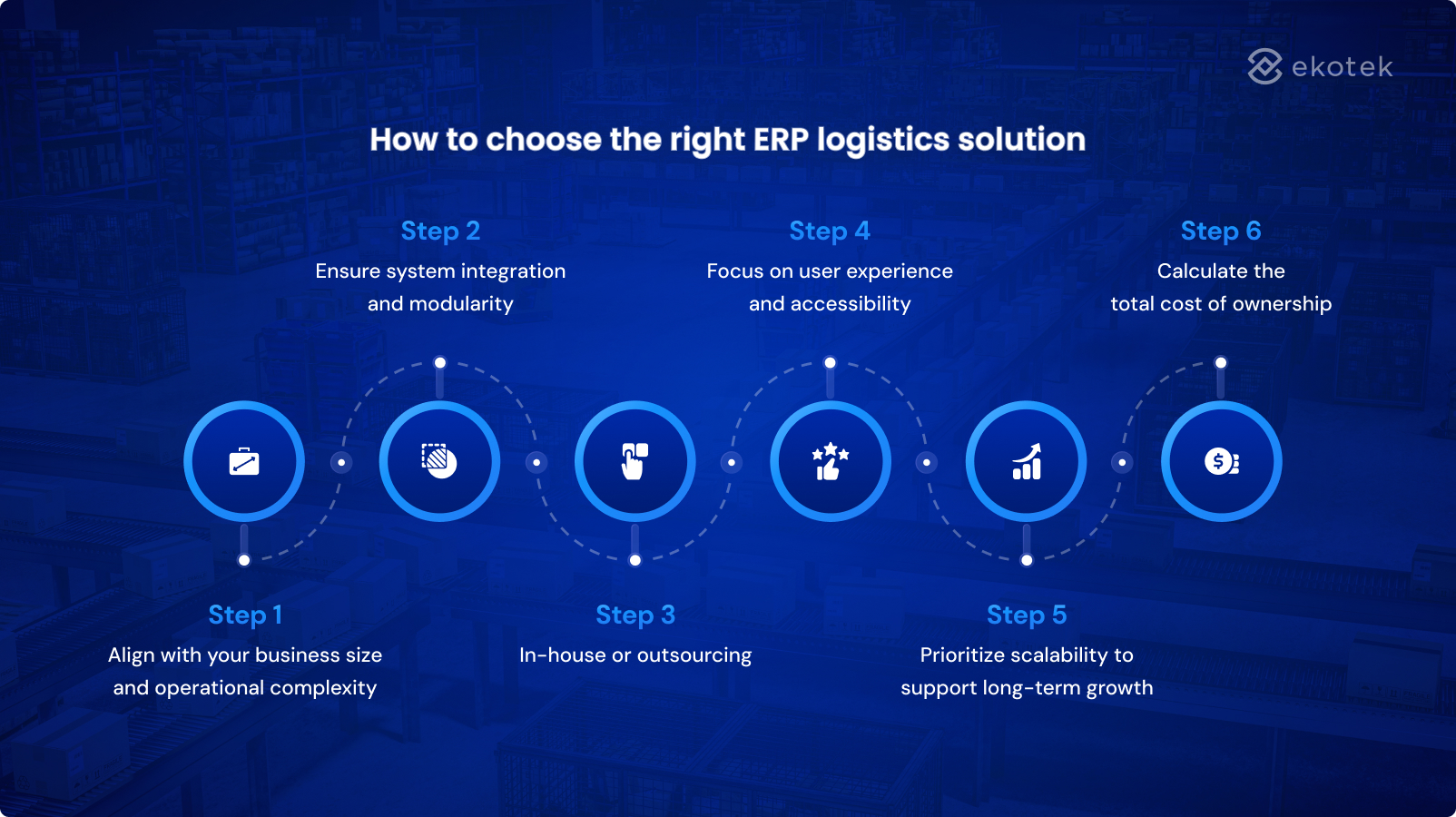 Align with your business size and operational complexity
Align with your business size and operational complexity
The logistics needs of a small distributor differ significantly from those of a multinational supply chain. A scalable solution should align with your business’s current processes and also accommodate future expansion, whether it’s geographic growth, increasing order volumes, or more complex workflows.
Before choosing a system, it’s essential to assess how your logistics operations function today and where they’re headed. A well-matched ERP logistics platform should grow alongside your business rather than limit it.
Ensure system integration and modularity
Modern logistics doesn’t operate in isolation. Your ERP logistics solution should integrate smoothly with other key systems like Warehouse Management Systems (WMS), Transportation Management Systems (TMS), and Customer Relationship Management (CRM) platforms.
Systems with modular architecture offer added flexibility. They allow you to implement core functionalities first, then expand with logistics-specific modules as needed, without disrupting the entire infrastructure.
Define your implementation strategy: In-house or outsourced
Once you’ve mapped out your operational needs, the next decision is how the ERP logistics system will be implemented. For some businesses, especially those without dedicated IT departments, outsourcing the ERP development or configuration may be more efficient than building it internally.
Partnering with an experienced ERP provider can reduce technical risk, shorten deployment timelines, and ensure the solution is tailored to your logistics workflows.
If you opt for outsourcing, look for firms with:
- Deep knowledge of ERP logistics processes
- Experience with similar business models
- Transparent post-launch support plans
This early decision can shape the rest of the selection process, including platform choice, integration scope, and timeline expectations.
💡 Learn what influences custom software development costs in our detailed guide
Focus on user experience and accessibility
An ERP system will only be as effective as its adoption by your teams. Poorly designed interfaces or overly complex workflows can delay onboarding and reduce productivity.
Prioritizing systems with intuitive dashboards, mobile accessibility, and role-based access ensures your logistics and warehouse teams can work efficiently, even in high-volume or time-sensitive environments. User-friendly design also lowers training costs and accelerates ROI.
Prioritize scalability to support long-term growth
As your business grows, your logistics operations will likely become more complex, more SKUs, more warehouses, more transportation routes, and possibly cross-border requirements. Your ERP logistics system must be able to scale accordingly, without requiring constant restructuring.
Look for solutions that can handle:
- Increasing transaction volumes and data loads
- The addition of new business units, locations, or product lines
- Future automation and analytics capabilities within the logistics function
A scalable ERP platform helps avoid operational bottlenecks and reduces the need for expensive re-platforming as your supply chain expands.
Calculate the total cost of ownership (TCO)
Beyond the upfront licensing fee, the full cost of an ERP logistics solution includes several long-term components:
- Implementation and configuration
- Customization and third-party integrations
- Employee training
- Maintenance and support
- System upgrades
Understanding the total cost of ownership ensures that your decision is not only technically sound but financially sustainable. A low initial price may lead to higher long-term costs if the system lacks essential functionality or flexibility.
Implementation challenges and how to overcome them
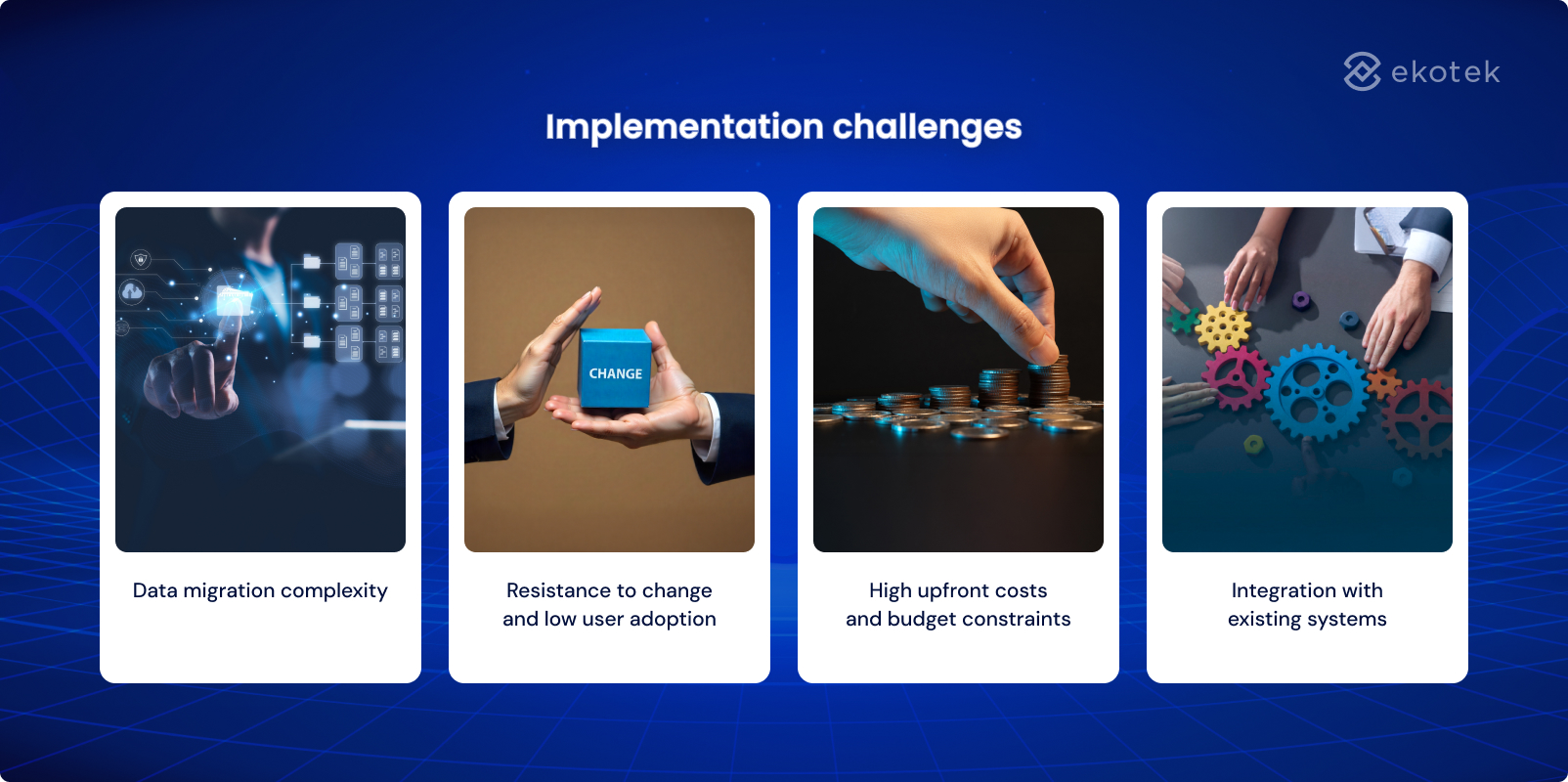 Data migration complexity
Data migration complexity
One of the most underestimated aspects of ERP implementation is transferring data from legacy systems. Logistics data often spans multiple formats and sources, including inventory records, shipping histories, order data, and supplier databases. Inconsistencies, duplicates, or missing information can delay implementation or compromise accuracy.
How to address it:
- Begin data cleansing well before the implementation timeline
- Prioritize critical data sets (inventory, order history, product SKUs)
- Use data migration experts or vendors with logistics experience to ensure structured transfer and validation processes
💡 Get practical insights and proven strategies in our ebook on application modernization
Resistance to change and low user adoption
ERP logistics systems affect day-to-day workflows across departments. If staff are not involved early or do not understand the system’s benefits, resistance to change is likely, leading to poor adoption and reduced ROI.
How to address it:
- Engage key users early in the process for feedback and testing
- Communicate clearly how the ERP system will solve specific pain points
- Provide hands-on training tailored to user roles and functions
- Identify and empower internal “champions” who can advocate and support adoption across teams
High upfront costs and budget constraints
ERP logistics projects often come with high initial investment, licensing, customization, infrastructure, and training. This can lead to internal pushback or budget reallocation if short-term value is not clear.
How to address it:
- Justify investment with long-term ROI projections: improved order accuracy, faster delivery times, better inventory control
- Consider a phased rollout starting with core modules (e.g., inventory, shipping) before expanding
- Explore cloud-based ERP options, which can reduce upfront infrastructure costs
Integration with existing systems
In logistics-heavy environments, ERP systems rarely operate in isolation. Integration with third-party tools, TMS, WMS, finance platforms, and CRM is often complex and can lead to data silos or workflow disruptions if poorly handled.
How to address it:
- Map out all current systems and data flows before implementation begins
- Choose an ERP solution with proven integration capabilities (open APIs, pre-built connectors)
- Work with implementation partners who understand logistics-specific systems and data structures
- Run integration tests in a sandbox environment before going live
Ekotek ERP: A comprehensive logistics management solution
For businesses seeking a robust ERP logistics solution tailored to the demands of modern manufacturing, Ekotek ERP offers an end-to-end platform designed to streamline operations across departments.
With a modular and fully integrated architecture, Ekotek ERP empowers businesses with the following capabilities:
- CRM: Segment customers, manage leads, track opportunities, and improve communication across channels.
- Sales management: Generate quotes, manage orders, define pricing rules, and analyze sales performance.
- Point of sale (POS): Support retail operations with multi-device POS, customer loyalty tools, and inventory sync.
- Purchasing: Automate RFQs, track purchase orders, and control invoices with vendor-specific workflows.
- Inventory management: Monitor stock levels, manage warehouse transfers, and improve forecasting accuracy.
- Manufacturing: Plan production, manage BOMs, and streamline scheduling with real-time visibility.
- Quality control: Create quality teams, define checkpoints, and automate alerts for consistent standards.
- HR and workforce: Manage employee data, attendance, recruitment, payroll, and workplace scheduling.
- Accounting: Integrate payments, automate invoicing, and reconcile banking transactions efficiently.
- AI integration: Leverage AI for demand forecasting, smart planning, real-time tracking, automation, and Smart Factory models using IoT and cloud technologies.
💡 Discover how AI integration can drive business value
Conclusion
In today’s fast-moving, disruption-prone environment, ERP logistics has become a critical enabler for businesses to streamline operations, improve visibility, and respond with agility. By integrating inventory, warehousing, transportation, procurement, and forecasting into a centralized system, often enhanced with AI, companies can reduce delays, optimize costs, and scale with confidence.
Ekotek provides more than just ERP software, we deliver future-ready logistics solutions tailored to your business. Our platform integrates cutting-edge technologies like AI, IoT, and Big Data, supports both cloud and on-premise deployment, and adheres to international standards in security and compliance. With agile low-code customization, 24/7 expert support, and a proven track record of helping clients boost productivity by up to 30%, Ekotek empowers your logistics operations to become faster, smarter, and more resilient, today and into the future.
Ready to transform your logistics and scale smarter? Contact Ekotek now for the next chapter of growth
- 1
- 2
- 3
- 4
- 5
- 6
- 7
- 8
- 9
